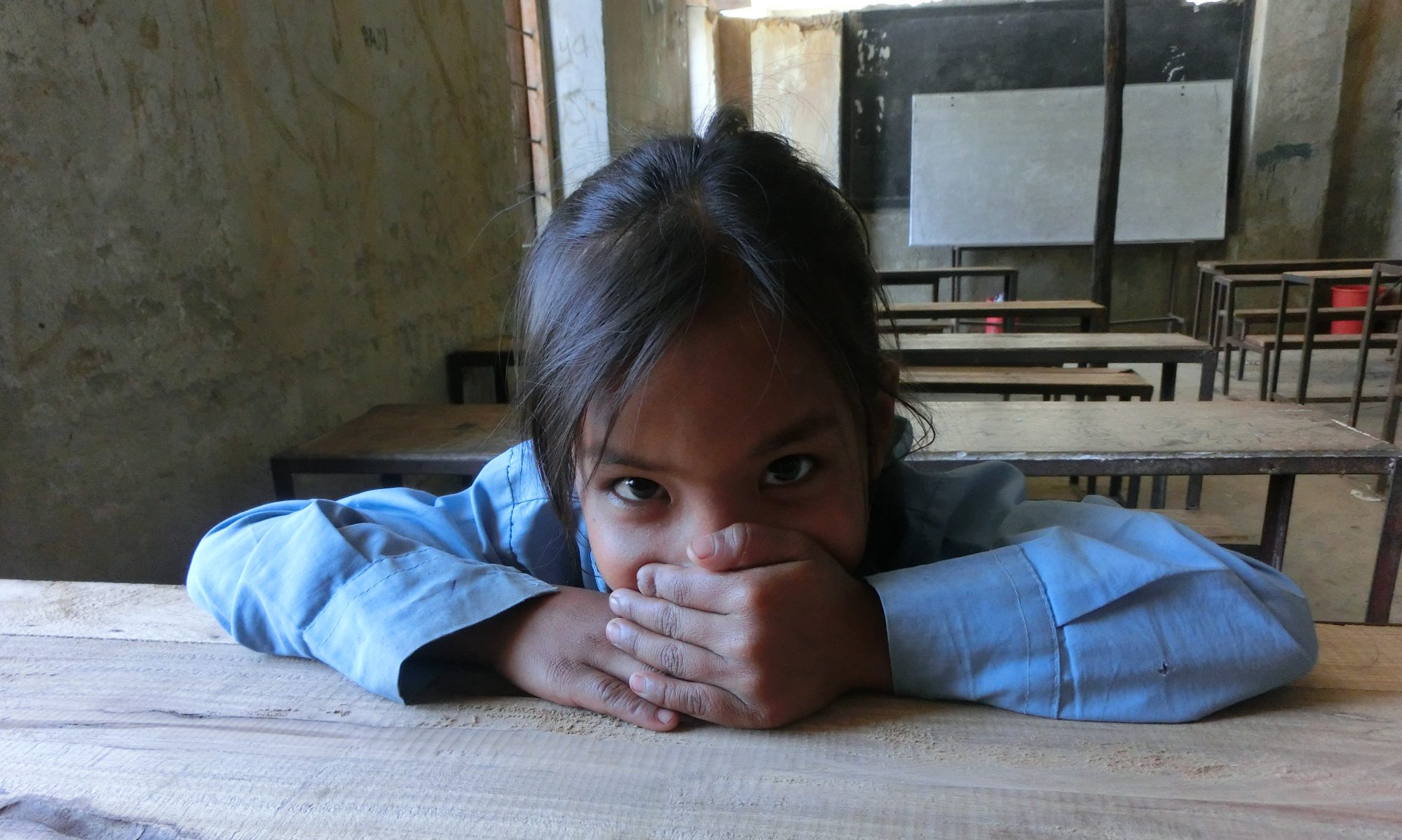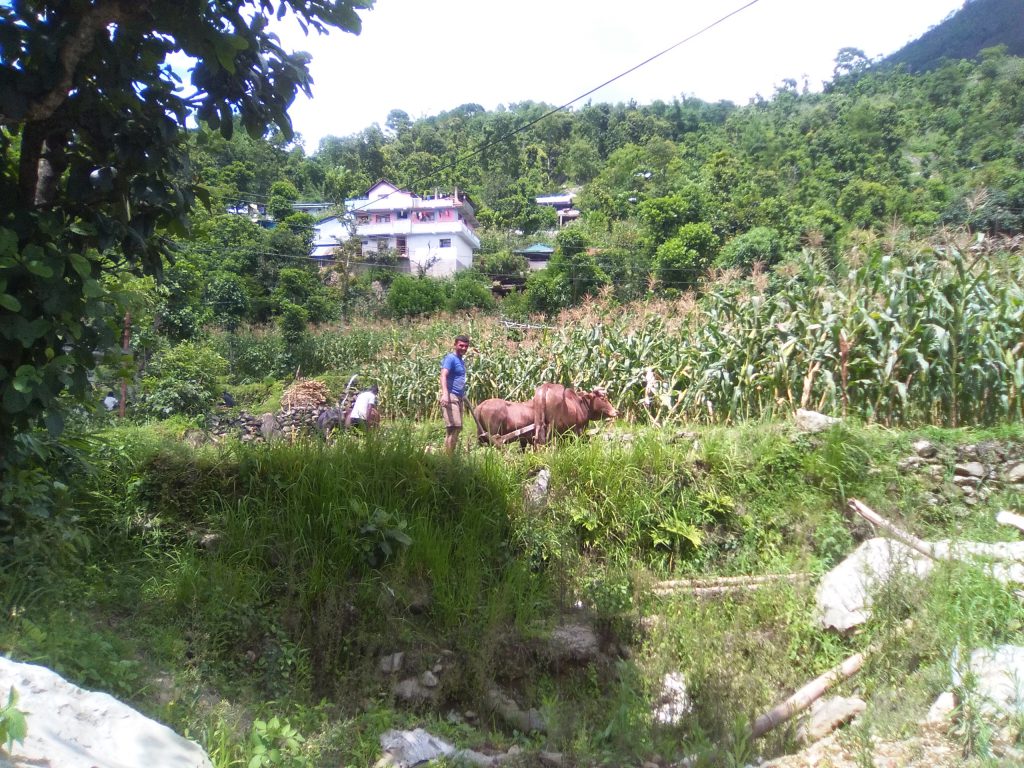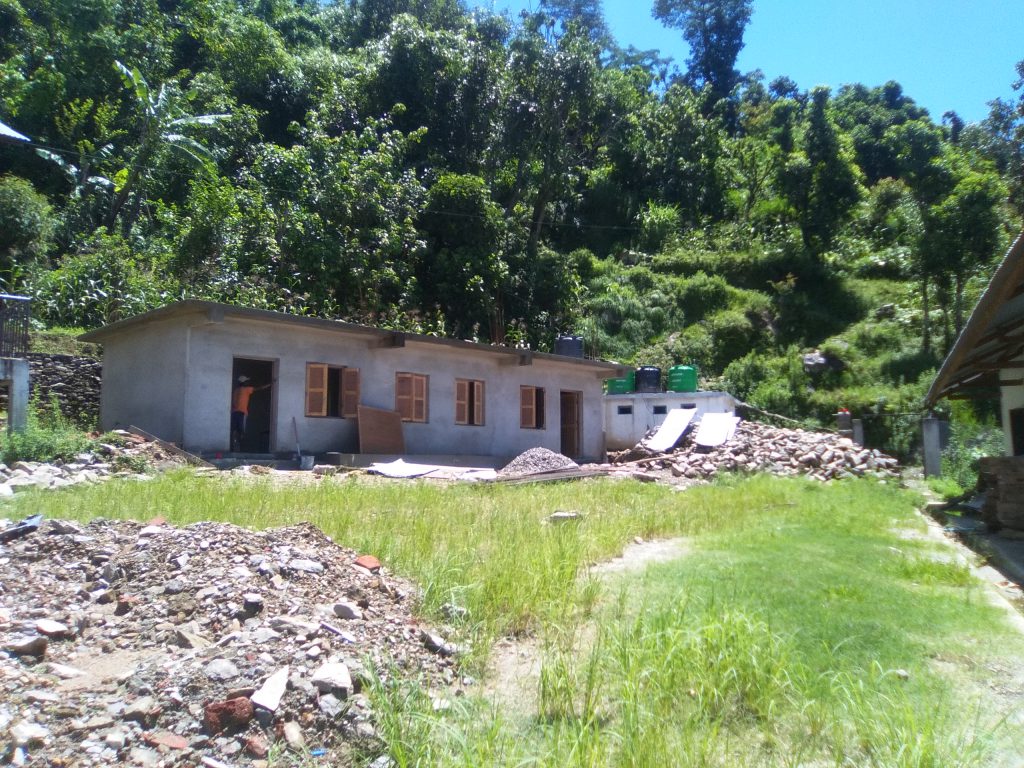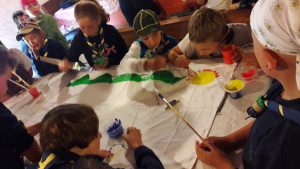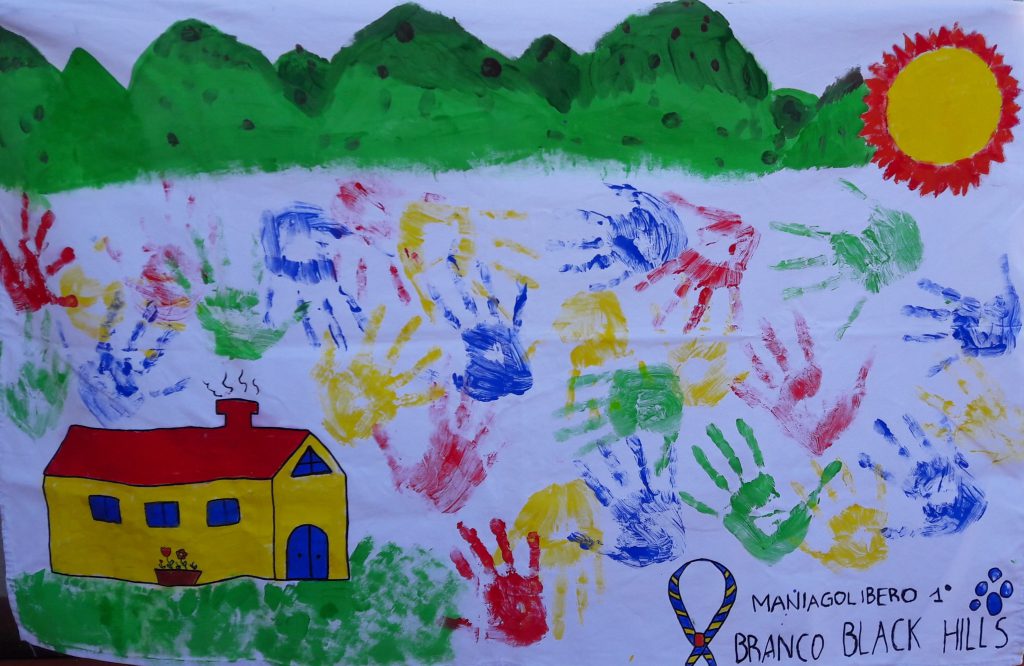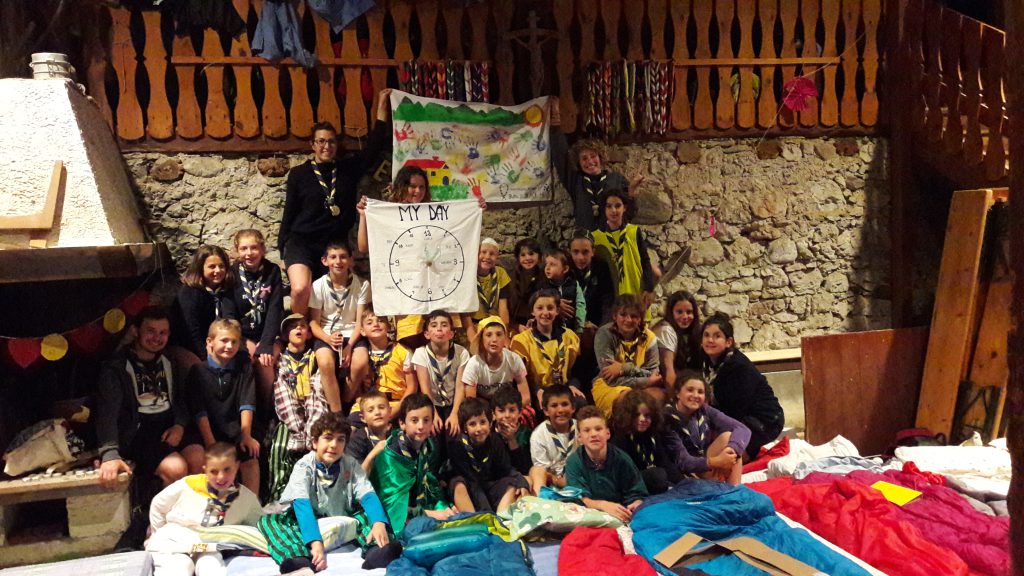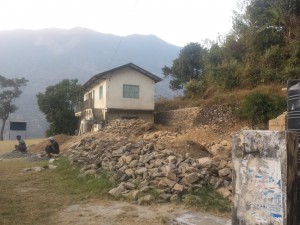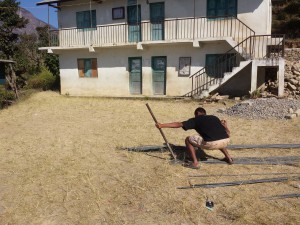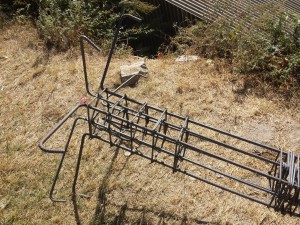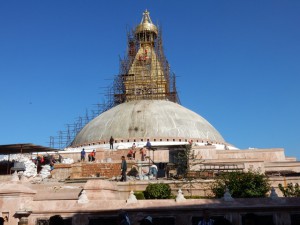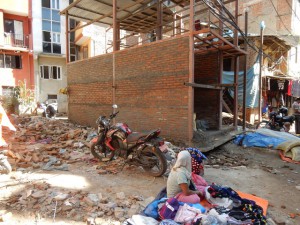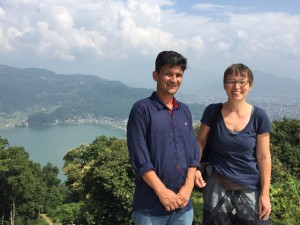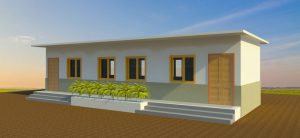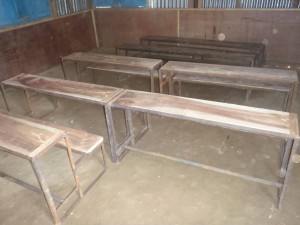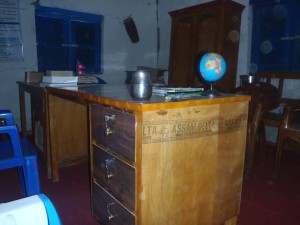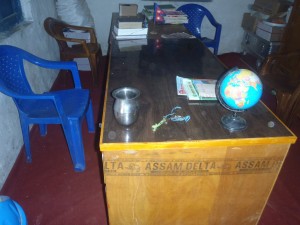We have currently no project running.
Our Nepali Life
The first thing you do before starting a volunteering experience is to look up the place where you will spend at least 2 months of your life. Most of the times God Google comes to help us…not in this case! We couldn’t find neither the little village not the province so the only thing we could say was “we are going somewhere in the north of Nepal!”. We were actually relieved by this fact since it meant that technology hadn’t reached this valley yet. For you, future volunteer, we make things a bit easier so here it goes the map with the village location.

 This was our little room. We actually loved it cause we felt a bit like survivors. We became good friends with our room-mates (the huge spiders) but we definitely hated it during raining nights. It literally felt like being hit by a hurricane, the sound was so loud that we couldn’t sleep because of the noise.
This was our little room. We actually loved it cause we felt a bit like survivors. We became good friends with our room-mates (the huge spiders) but we definitely hated it during raining nights. It literally felt like being hit by a hurricane, the sound was so loud that we couldn’t sleep because of the noise. Animals are fundamental in a Nepali family and sometimes they worth more than people. Curiosity, if you kill accidentally a cow (holy animal for Hindu) you have exactly the same years of jail as killing a man! The same with ducks, you can face up to 20 years of jail if you accidentally kill one. Luckily we weren’t driving and we didn’t see any duck in Karmidanda otherwise we would have written the “Orange is the new black: Nepali version“. So after the field it was breakfast time. Usually Nepali people only drink kalo (black) or dut (milk)
Animals are fundamental in a Nepali family and sometimes they worth more than people. Curiosity, if you kill accidentally a cow (holy animal for Hindu) you have exactly the same years of jail as killing a man! The same with ducks, you can face up to 20 years of jail if you accidentally kill one. Luckily we weren’t driving and we didn’t see any duck in Karmidanda otherwise we would have written the “Orange is the new black: Nepali version“. So after the field it was breakfast time. Usually Nepali people only drink kalo (black) or dut (milk)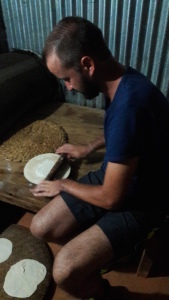
The school was located in the neighbouring village and was attended by nearly 250 students of the surrounding. I had to walk every day from Sunday to Friday at least 30 minutes to reach it (good training for my button!). 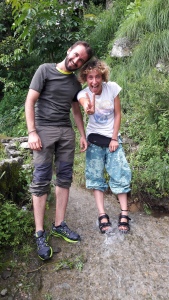 Reading some recent Italian news about how it might become compulsory for the parents to pick up the kids from school until they are 13 years old, it just made me laugh! In our school, 4 years old kids used to walk alone, in the forest, for at least an hour just to have the chance to study and change their destiny. Since the school was at the bottom of the hill it was even more difficult to reach it during rainy season since the little path turned into a river. But these little worriers with their little umbrellas always managed to be on time (on the other side I used to fall down at least 3 or 4 times on my way). The school area was composed by different buildings: some existed before the earthquake, others (the metallic shelter) were constructed after the earthquake and one building was brand new and has been given in donation by Walk Along. In the same spot where the new classes were erected, there were the original classes that had been completely destroyed by the earthquake. Luckily there were no kids inside since the earthquake happened on Saturday so no one was at school. Due to the mentioned bureaucracy it took more or less 2 years to complete the quake proof building. It originally consisted of a single floor but, of course, in the Nepali vision no houses
Reading some recent Italian news about how it might become compulsory for the parents to pick up the kids from school until they are 13 years old, it just made me laugh! In our school, 4 years old kids used to walk alone, in the forest, for at least an hour just to have the chance to study and change their destiny. Since the school was at the bottom of the hill it was even more difficult to reach it during rainy season since the little path turned into a river. But these little worriers with their little umbrellas always managed to be on time (on the other side I used to fall down at least 3 or 4 times on my way). The school area was composed by different buildings: some existed before the earthquake, others (the metallic shelter) were constructed after the earthquake and one building was brand new and has been given in donation by Walk Along. In the same spot where the new classes were erected, there were the original classes that had been completely destroyed by the earthquake. Luckily there were no kids inside since the earthquake happened on Saturday so no one was at school. Due to the mentioned bureaucracy it took more or less 2 years to complete the quake proof building. It originally consisted of a single floor but, of course, in the Nepali vision no houses 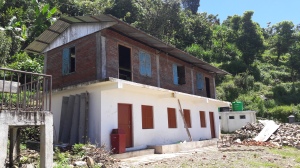 can have ONLY a single floor! So while we were there they had the brilliant idea to build a second floor (made by the local workers with no construction plan) without asking any permission to the organization! Jointly with the karma and fatalism (following one of the teacher my good karma helped me avoid the bricks falling down from the roof of the new rooms) this is a fundamental aspect of the Nepali culture: if you don’t ask me, why should I tell you? No one asked to the school board if they would have built another floor! The same logic is applied when you ask the hours: “Sir, do you have the time?” “Yes!” And then they will just walk away without giving you the time!!!
can have ONLY a single floor! So while we were there they had the brilliant idea to build a second floor (made by the local workers with no construction plan) without asking any permission to the organization! Jointly with the karma and fatalism (following one of the teacher my good karma helped me avoid the bricks falling down from the roof of the new rooms) this is a fundamental aspect of the Nepali culture: if you don’t ask me, why should I tell you? No one asked to the school board if they would have built another floor! The same logic is applied when you ask the hours: “Sir, do you have the time?” “Yes!” And then they will just walk away without giving you the time!!!
My lessons covered the all morning and afternoon. The school started at 9 to allow all the students to walk from the villages and be on time and finished at 4.  Classes were quite short, only 45 minutes and in my case they were even shorter cause I spent ages to make all the students seat and listen to me XD Everyone has experienced a new and young teacher at school so we all know how to make fun of them at the beginning. The same happened to me, and I was even a foreigner! First of all the students name were just impossible to memorize and, when I made them create a name tag they kept changing it every time to confuse me!
Classes were quite short, only 45 minutes and in my case they were even shorter cause I spent ages to make all the students seat and listen to me XD Everyone has experienced a new and young teacher at school so we all know how to make fun of them at the beginning. The same happened to me, and I was even a foreigner! First of all the students name were just impossible to memorize and, when I made them create a name tag they kept changing it every time to confuse me! On the other side, they immediately memorized my name and instead of calling me Miss, like they used to call the other teachers, they called me Didi that in Nepali means older sister. Is it possible to get angry with these beautiful creatures when they call you like that while looking at you with these eyes??? IMPOSSIBLE. So they basically understood that they could manipulate me whenever.
On the other side, they immediately memorized my name and instead of calling me Miss, like they used to call the other teachers, they called me Didi that in Nepali means older sister. Is it possible to get angry with these beautiful creatures when they call you like that while looking at you with these eyes??? IMPOSSIBLE. So they basically understood that they could manipulate me whenever.
A common thing of the Nepali is that they are really really curious and have no idea of the privacy concept. Even if they just know you they will ask you: “How old are you? Are you married? Which job are you doing? (In this exactly sequence). Then they will start showing you the picture of their family, house etc. With kids is more or less the same, only the question slightly change “What is your mother name? What is your Didi name? What is your Bai (little brother) name?” And finally “Chocolate?(Seriously, who is the foreigner who started this game with the Nepali kids? We will find you one day…)
The time passed really fast, and everyday I was getting closer and closer to the kids. Since the begging I understood that playing game was the easier way to teach them English and, for them, to teach me Nepali. While they perfectly learned thes tendipanni song in less than 1 week, it took me nearly 2 months to learn a sentence of Kuttuma Kutu!
One of the task the organization gave us was to decorate the classes, so we decided that it would have been a good idea to hang a world map. 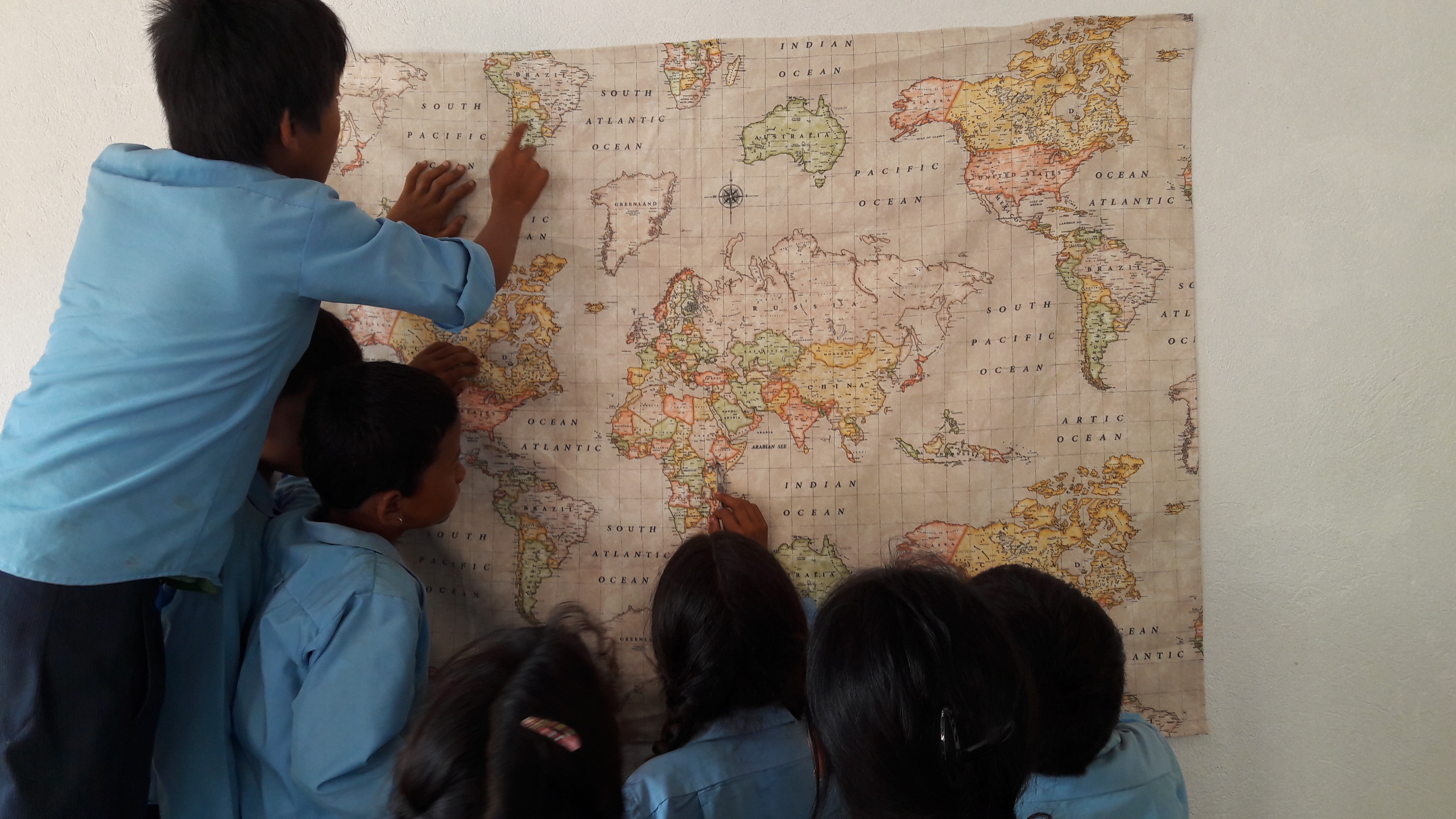 When I asked class 5 where Nepal was located they immediately pointed…Madagascar! Once understood that geography wasn’t their favourite subject, we started analysing all the continents until reaching Qatar when most of the kids yelled: “My dad lives here!”
When I asked class 5 where Nepal was located they immediately pointed…Madagascar! Once understood that geography wasn’t their favourite subject, we started analysing all the continents until reaching Qatar when most of the kids yelled: “My dad lives here!”
A sad truth is that most of the kids have not seen their father in the last 7-8 years. A big part of the Nepali population live in fact in countries such as Qatar or AEU. They leave their family with the illusion of finding a well-paid job but, once there, only exploitation is waiting for them. Usually, once arrived, the employer takes their passport and only gives it back to them after 3 years. In this way, they cannot leave the country (they couldn’t even come home after the earthquake to see if the family was ok). At the same time the family cannot leave Nepal since, even if they have enough money for paying the flight, Nepali cannot travel (even for tourism) without a recommendation letter from the foreign country. In other words, the foreign person who will host the Nepali guest needs to certify that he or she will pay all the expenses during the stay…when we discovered it we started to appreciate even more our liberty of movement.
Every teacher has a favourite student, and for me Sustika, was my special Boini (little sister)! She had mental retardation and even if she was 7 years old she was still in class 1.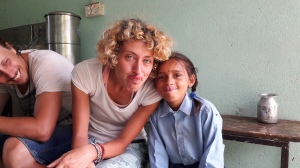 Unfortunately, most of the time the family is just too busy to look after kids and the teacher are paid way to less (250$ a month) to take care of them. The saddest thing for me was to see how no one really took care of the kids during school time and, some of them, even used way to often violence to “make them learn faster”. Under these circumstances, even a little smile makes you the new best friend of a little girl. And this is what happened with Sustika. Every time she saw me she ran after me and she used to sing me a Nepali song about the family. The hardest part of this experience, was to see her running towards me and give me her last hug. But she made me a promise, she won’t grow too fast so even next time I will be able to lift her!
Unfortunately, most of the time the family is just too busy to look after kids and the teacher are paid way to less (250$ a month) to take care of them. The saddest thing for me was to see how no one really took care of the kids during school time and, some of them, even used way to often violence to “make them learn faster”. Under these circumstances, even a little smile makes you the new best friend of a little girl. And this is what happened with Sustika. Every time she saw me she ran after me and she used to sing me a Nepali song about the family. The hardest part of this experience, was to see her running towards me and give me her last hug. But she made me a promise, she won’t grow too fast so even next time I will be able to lift her!
was a little building composed by different offices and a birth place room. In Nepal the health situation is really poor: there are few good hospitals and they are all located in the capital (just to make you understand, the Nepali politics prefer to get cured in Bangkok rather than here!). If this is the situation in the capital, you can imagine how it is in the remote villages! In Karmidanda health post there was only a nurse and no doctor (in most of the places is like this or, even worst a paramedic who undertook a 8 month course in medicine…) Most of the time the personal is not fully qualified and this represented for me a big challenge. The patients are not checked properly and antibiotics are given as candies. This is a real issue in Nepal since, not needing a prescription, people are hardly abusing it.
So after a couple of weeks, I had to give a turn in my position and, even if with resignation, leave the health post and focus more on the school. I really wanted to be more useful in the health post since it would have been a resource even for the village, but sometimes you need to face the cultural aspect and make a step back. On the other side at the school there was no time to get bored! First of all, we painted all the library in order to try to save the books from the mould! It was tougher than I though since the concept “Don’t touch” doesn’t exist in the Nepali culture. Every time that I just finished painting there was someone, students or even teacher, that had to personally check with their finger if the painting was really fresh! Secondly we reorganized all the books by topics (like in a normal library) and teach to the kids how to read the books instead of only passing the pages (we think they understood now :). Since the dean admired my Michelangelo skills, he asked me to paint even the new rooms. We decided to draw a big tree  representing the fact that students grow with learning and a girl flying with balloons with the written “learning gives you freedom”. We decided this “controversial” subject in order to make femalet sudents understand that they worth as much as boys and that only studying they can really get free from a society where, if the new born is a female it is still considered a disgrace. In Nepal, girls don’t have the
representing the fact that students grow with learning and a girl flying with balloons with the written “learning gives you freedom”. We decided this “controversial” subject in order to make femalet sudents understand that they worth as much as boys and that only studying they can really get free from a society where, if the new born is a female it is still considered a disgrace. In Nepal, girls don’t have the  same chance of studying as boys: while the family will pay up to university for their sons, the daughter can attend only until 5th grade for then leaving school and start working. That is why we used the word controversial and that is why we made this painting in class 5.
same chance of studying as boys: while the family will pay up to university for their sons, the daughter can attend only until 5th grade for then leaving school and start working. That is why we used the word controversial and that is why we made this painting in class 5.
But I didn’t only paint! I tried to use my medicine knowledge and transmit it to the students through 3 sessions of first aid. It was a really funny experience, especially when I pretended to be a dead person and a student tried to reanimate me with the CPR movement nearly breaking me all the ribs (for real in this case). With no doubt, the funniest part of my experience was doing the health check to all the students (including the teachers). Kids from class 1 never saw a doctor in their life so they were pretty impressed and curious by my stethoscope!!! 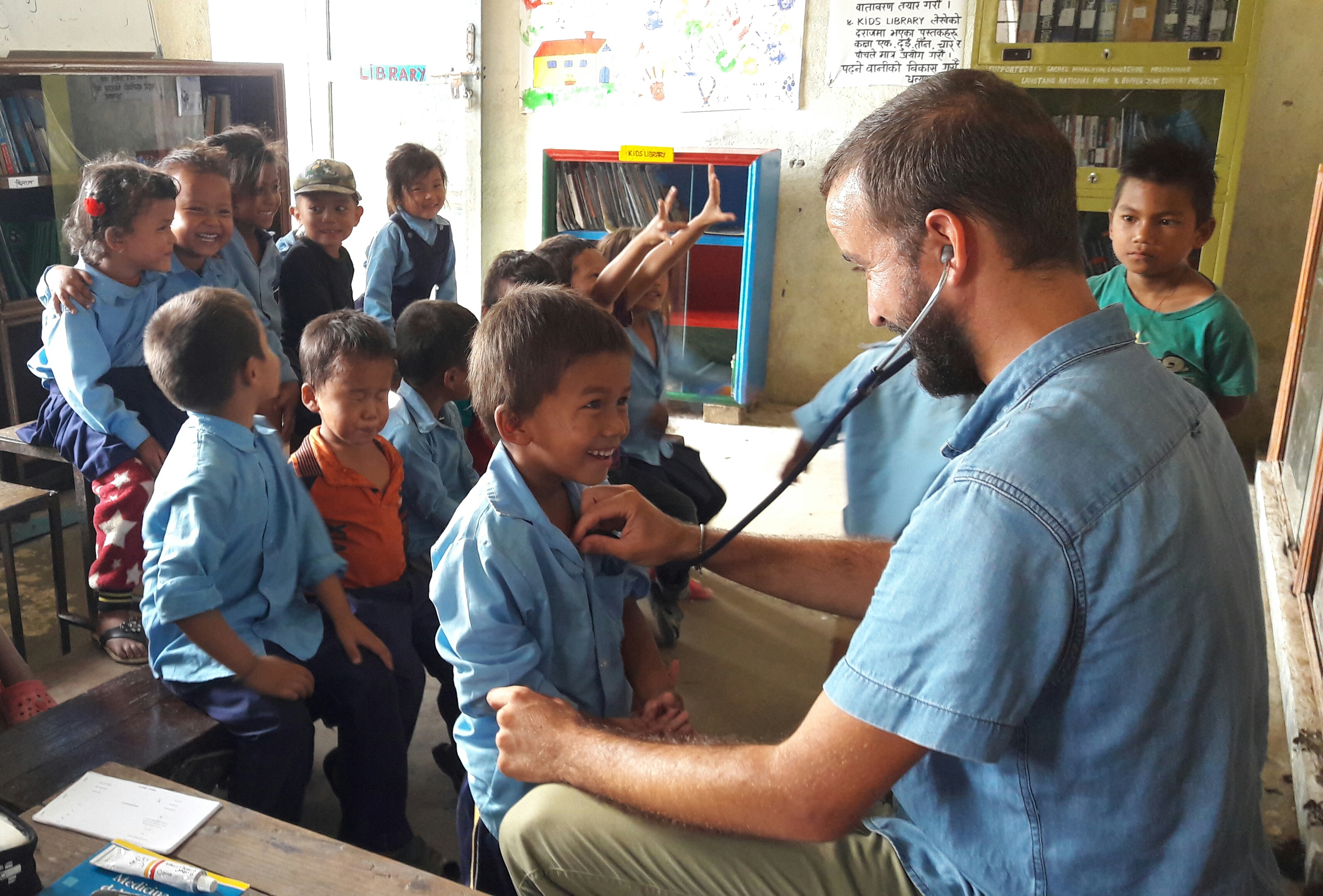 The results of this intent of being a doctor inside the school was that every 5 minutes a kid would arrive with a scratch asking “Sir Javi, can you cure me?”…. And with a smile, how could I say no? The effect of this training session spread even outside the school walls and little by little the villagers started to come at our house looking for the doctor. As a pay back I received loads of presents such as delicious buffalo milk, goat meat or yak cheese! My conclusion? Is great to be a doctor in a Nepali village!
The results of this intent of being a doctor inside the school was that every 5 minutes a kid would arrive with a scratch asking “Sir Javi, can you cure me?”…. And with a smile, how could I say no? The effect of this training session spread even outside the school walls and little by little the villagers started to come at our house looking for the doctor. As a pay back I received loads of presents such as delicious buffalo milk, goat meat or yak cheese! My conclusion? Is great to be a doctor in a Nepali village!
Women condition
 We have always thought that Spain was the country with most festivities in the world…we were wrong! Nepali festivals double the typical European celebration. Every month there is a special event and if there is not, they invent it! Every day we had to ask if there would have been class the day after and, at least once a week there was a day off for: the day of children rights, the day of teacher rights, the day of games…during our staying at the village we have experienced 2 major festivals: the Gaai Jatra, where they usually honour a cow since is the mean used by the souls to reach Yamrai (the god of death), and Tijr, the Women festival. In Europe too we celebrate women on the 8th of March, but the meaning here is quite different. In the Tijr, women dress up with their most beautifuls saari and celebrate in front of the Shiva temple…for their husband or future husband! Once again, the only festival dedicated to women, undercover a veneration for men.
We have always thought that Spain was the country with most festivities in the world…we were wrong! Nepali festivals double the typical European celebration. Every month there is a special event and if there is not, they invent it! Every day we had to ask if there would have been class the day after and, at least once a week there was a day off for: the day of children rights, the day of teacher rights, the day of games…during our staying at the village we have experienced 2 major festivals: the Gaai Jatra, where they usually honour a cow since is the mean used by the souls to reach Yamrai (the god of death), and Tijr, the Women festival. In Europe too we celebrate women on the 8th of March, but the meaning here is quite different. In the Tijr, women dress up with their most beautifuls saari and celebrate in front of the Shiva temple…for their husband or future husband! Once again, the only festival dedicated to women, undercover a veneration for men.
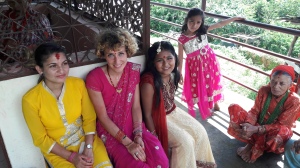
As explained in the section above, be a woman in Nepal is still difficult! Give birth to a little lady is still considered a course for most of the family since, when she will be ready to get married, the family will have to pay a big dowry to the future husband. In developed countries, when a woman is pregnant is possible to know in advanced the sex of the new born. This medical exam is considered illegal in the Nepali hospitals since, if the family discovers that the future baby will be a girl they will immediately ask for abortion (unfortunately is possible to do the exam by paying a “little sum” to the doctor). At the same time, there is a huge pressure on the mother since, if she is not “good enough” to give birth to a son, the husband has all the right to get married with another women.
Another alarming example is that, in 2017, the Chhaupadi is still normal. The Chhaupadi is a hindu tradition that prohibits women from taking part in normal family activities during the menstruation period. When a girl has the first period, she is considered impure. The family takes her and put it in a shelter with no light where she will spend there 4-5 days until her period is over. She cannot see the sun and even stare at the vegetable or fruit cause otherwise they will turn bad. In some cases this practice is applied only for the first period but, most of the time, especially in the Terai where the Hindu tradition is stronger, is repeated every month. Luckily, this September, the government classified this practise as illegal, after that 2 young girls died of a snake bite and no one helped them. Unfortunately we don’t think it will change the situation that much. Nepal has one of the highest rate of suicide in the world and most of them are committed by women. Is the country with the highest rate of underaged weddings, 60%. We were pretty shocked to discover that our Ama got married at the age of 7 with a 23 year old man…we couldn’t even sleep alone at that age! Little by little the situation is changing, love marriages are spreading, especially in the city, and girls are having more opportunity compare to their mothers. Still there is a lot to do and, luckily, there are organization such as Apeiron (www.apeironglobal.org), that are making this change a reality!
Sightseeing in the valley
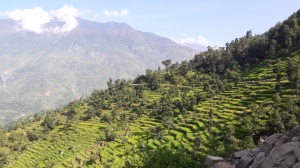 Volunteering does not mean only work but even enjoy the beautiful environment that surrounds you! We were extremely lucky to spend two months in this remoted area out of the tourist trekking paths. From Karmidanda you can reach many different destinations. On our free day we used to walk up the hill to the so-called Calgari rock,
Volunteering does not mean only work but even enjoy the beautiful environment that surrounds you! We were extremely lucky to spend two months in this remoted area out of the tourist trekking paths. From Karmidanda you can reach many different destinations. On our free day we used to walk up the hill to the so-called Calgari rock, where you have an amazing view of the valley or take a bumpy and pretty scary road to Dunghe, the entrance of the Langtang park, only to buy yummy yak cheese. Highly recommended is to go down to the Trisuli river, the only river that has water all year around. From there you can reach, especially during monsoon time, breathtaking waterfalls! If you like wild animal you can spot Himalayan monkeys while stealing rice from the villagers, and, if you are lucky enough leopards and bears. Unfortunately we didn’t see any of them but people told us that they still surround the area.
where you have an amazing view of the valley or take a bumpy and pretty scary road to Dunghe, the entrance of the Langtang park, only to buy yummy yak cheese. Highly recommended is to go down to the Trisuli river, the only river that has water all year around. From there you can reach, especially during monsoon time, breathtaking waterfalls! If you like wild animal you can spot Himalayan monkeys while stealing rice from the villagers, and, if you are lucky enough leopards and bears. Unfortunately we didn’t see any of them but people told us that they still surround the area.
It is difficult to resume in just few words our amazing experience so, the best way to understand the Nepali culture is to go and check yourself. For the future volunteers, we would like to give you the following tips.
Do you want to volunteer with us? All you need to know:
- The most important thing is to be really open minded and flexible. You will face a cultural shock when you arrive, but after few days you will easily adapt. Understand that the European and Nepali way of living are completely different.
- While volunteering, respect you colleagues but, at the same time, don’t be afraid in expressing your opinion. Culture and tradition does not mean that you can’t introduce changes and improvement. Be creative and when you think you are doing the right thing, follow your instinct.
In the last years, few shops opened in the village. You will have the chance to buy - While volunteering, respect you collegue but, at the same time, don’t be afraid in expressing your opinion. Culture and tradition does not mean that you can’t introduce changes and improvement. Be creative and when you think you are doing the right thing, follow your instinct.
- In the last years, few shops opened in the village. You will have the chance to buy food and drink (biscuits, soft drink, beer) directly in Karmidanda. For more “sofisitacted stuff” (such as toilet paper or sanitary pad) you have to reach the closest village (Kalikstan).
- For those who wants to socialize with local people, go to Shanti bar. It is a really local and lovely place, that all the villagers know. You can try the local raksi (attention, it is quite strong XD)
- We highly recommend you to buy a Sim card in Kathmandu. We bought a Ncell one for 600 rupees in total (SIM and recharge with data) and is really useful in case of emergency.
- You will eat every day Dal Bath, but the family is really open to introduce some changing. You can buy once in a while some chicken in the neightbouring village and they will cook it in an awesome way.
Colorful Karmidanda
Nowadays, the little village of Karmidanda looks like a raimbow nowadays. The vegetables, plants and flowers are growing little by little and most of the houses have been rebuilt. Luckily, the bad memories of the heavy earthquake are fading away.
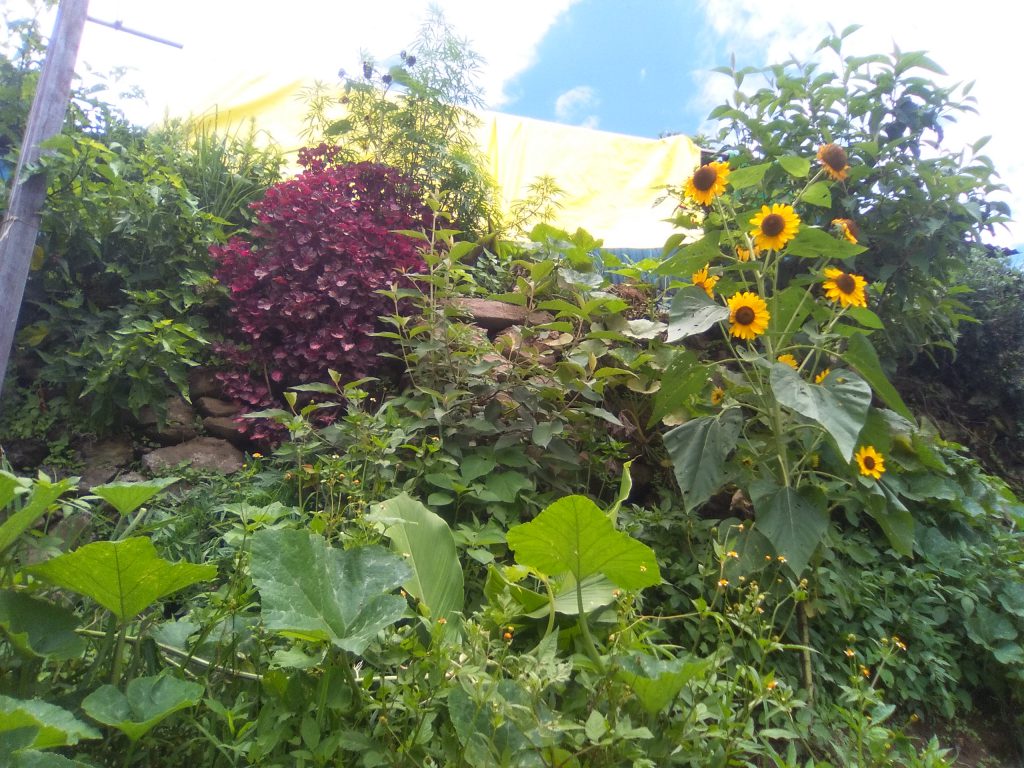
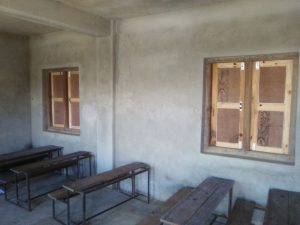
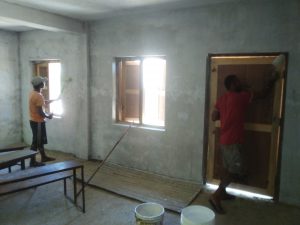
At the moment, our Italian partner Roberto is checking the situation in Karmidanda. He sent us these wonderful pictures of the village and the finished school.
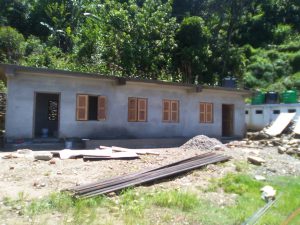
The all building looks a bit unfriendly, but one of the tasks of our next volunteers will be to paint the walls and decorate the classes jointly with the children.
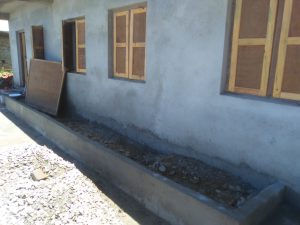
Now lessons can finally take place!
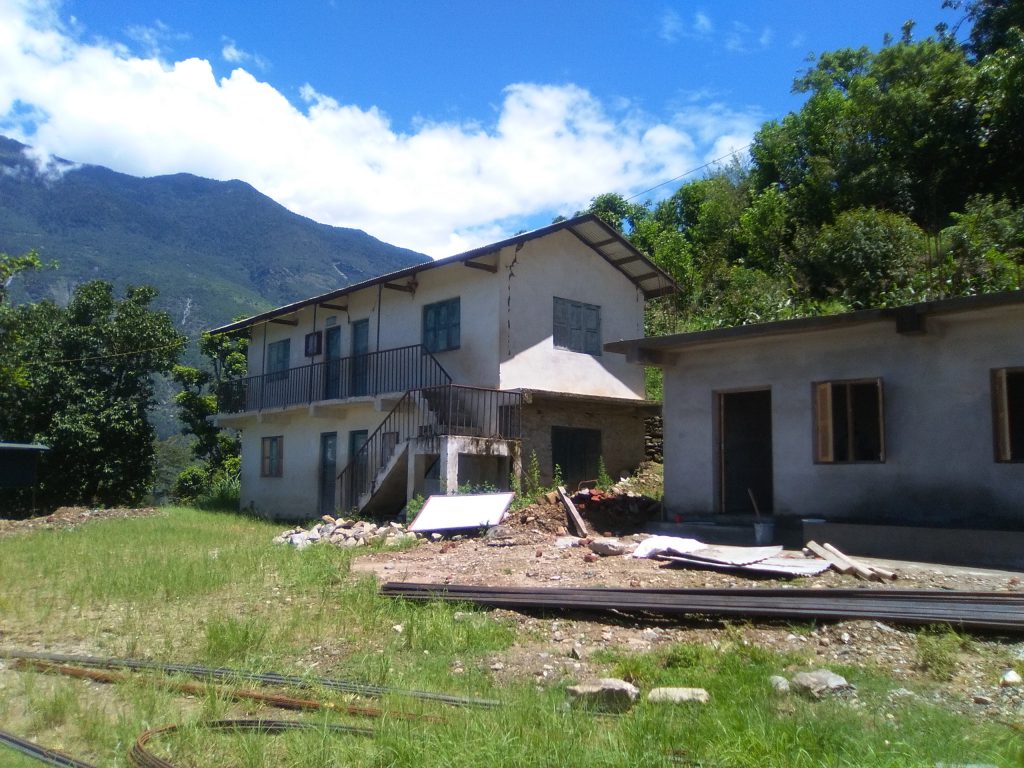
New Volunteers
In a couple of weeks, two new volunteers will take part in the WalkAlong project in Nepal.
Valentina and Javi are really thrilled to start this new experience and are really looking forward to support the different activities in the village of Karmidanda. Valentina will be mainly involved in the educational project, while Javi, being a GP, will provide useful support at the health check point.
In these weeks previous to their departure, they have decided to involve the local community in Italy in this volunteering project. In particular, the Scout Community of Maniagolibero has enthusiastically accepted this proposal, since they share the same goals as WalkAlong: help the people in need, support education and create a better environment.
Valentina reported us about the special day at the summer camp: “We have decided to involve the community of my little village in order to create a multicultural project and cross the information between the two communities. 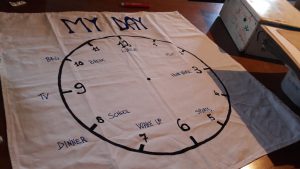 The aim of the activity was to allow the kids to understand how local community in Nepal lives, and especially help with the new school project. Jointly we have created a clock evidencing the different activities that a normal kid in Italy carries out during the day. In this way, once in Nepal, we can realize the same exercise with the kids of Karmidanda, comparing the different living styles.
The aim of the activity was to allow the kids to understand how local community in Nepal lives, and especially help with the new school project. Jointly we have created a clock evidencing the different activities that a normal kid in Italy carries out during the day. In this way, once in Nepal, we can realize the same exercise with the kids of Karmidanda, comparing the different living styles.
After learning few Nepalese words such as Namaste, the Scouts had a wonderful idea and decided to paint a beautiful picture in order to decorate the walls of the new school. The painting is not meaningless since every little part has been created with a purpose:
1)The mountain represents the connection between our community and the Nepali one. Here in Friuli we have beautiful mountains (even if smaller compared to the Himalayan jeje);
2)The sun represents the rising. Like after the rain, the sun always shines, the same is happening in Nepal after the earthquake. The sun represents the hope and the fact that every day there is a new beginning;
3)The hands represent the greetings of the Italian kids to their new Nepali friends.
It has been quite emotive to see how the kids got so involved in this project and were really concerned about the Nepalese friends.
Heartfelt thanks to the Scout community for their help!”
Javi and Valentina, will definitely keep us updated about their new adventure!!!
School updating
Today, we are really pleased to announce that we are still on schedule with the reconstruction of Karmidanda´s School!
The local construction company managed to complete 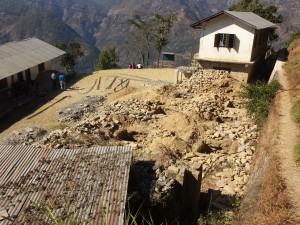 the first construction phase within one week. Quite a tough work if you think that the excavation for the eight basic piles of the building has been carried out at a depth of 1.50 meters – and without the use of any machine! All the work has been carried out manually: even the rocks has been crushed handily!
the first construction phase within one week. Quite a tough work if you think that the excavation for the eight basic piles of the building has been carried out at a depth of 1.50 meters – and without the use of any machine! All the work has been carried out manually: even the rocks has been crushed handily!
The foundations of the school were laid on Monday, December 12, 2016.
These are the followed steps: first of all, the excavated holes are filled with some grounded soil, pressed and then followed by a narrow layer of larger stone blocks.
The steel piers are prepared on site too! Each individual element has been shortened and bent in order to create quite long steel rods.
These are the so-called “Elephant Feets”. They represent the structure´s base and are fixed with a layer of cement, stone chips, cement, sand and water in order to reach the height of the future foundation.
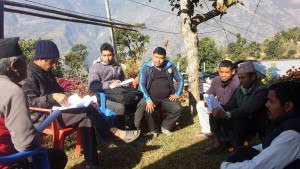
Groundbreaking for the teaching buildings. At 10:30 am local time (UTC + 5:45), the first groundbreaking ceremony was set for the foundation of the two classrooms.
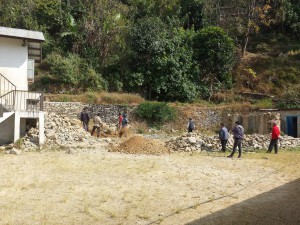 Groundbreaking News: Foundation for the New School Building is set. Around 10:30 at local time, the construction of two new classrooms has ended with the groundbreaking ceremony. Several meeting has been carried on by the architect and the appointed person in charge in order to make the final arrangement and solve different issues.
Groundbreaking News: Foundation for the New School Building is set. Around 10:30 at local time, the construction of two new classrooms has ended with the groundbreaking ceremony. Several meeting has been carried on by the architect and the appointed person in charge in order to make the final arrangement and solve different issues.
Thanks to all the partners that will support the construction phase in the following months!
“We will rise again!”
– We will stand up again –
This slogan, painted on a bus, undoubtedly shaped and guided our thoughts throughout our 3 weeks trip in Nepal. We mainly wanted to visit our dear friends in Karmidanda and also check the actual status of the school and of the project in general. Beaten Sitter from Sülzhayn, who was able to gather unforgettable impressions after the unique donation campaign of the Jugendsozialwerk Nordhausen last year, was now accompanied by her daughter, Franziska Sitter, from Dresden.
The reconstruction is taking place at a really slow path and there is still a lot to do. Everywhere foreign tourists can see and touch the tangible consequences of the Earthquake. The oppressive mood of the last year has given way to a general excitement. Noise, dust, vehicle congestion and traffic jams are bringing Kathmandu back to its everyday chaotic routine.
During our trip, we celebrated one of the largest Hindu festival: the Dashain Festival.
The speeches were quite emotional, not only talking about hopes but even featured by worries and needs of different generations that, unfortunately, have been affected by the same tragedy.
At las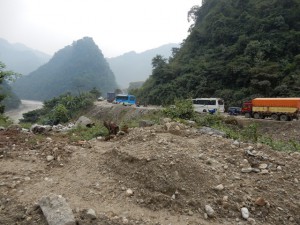 t the constant aftershocks have stopped. A part from the earthquake, Nepalese people have to struggle with other climate issue! For example, during the monsoon season is quite usual that buses gets stuck for hours do to landslide blocking problems. For us, Europeans, it is incomprehensible to stand, several hours or even days, patiently In a bus!But the experience of taking a bus ride of 10 hours, allowed us to share this “routine” with the inmates of hundreds of buses ahead of us and behind us as well.
t the constant aftershocks have stopped. A part from the earthquake, Nepalese people have to struggle with other climate issue! For example, during the monsoon season is quite usual that buses gets stuck for hours do to landslide blocking problems. For us, Europeans, it is incomprehensible to stand, several hours or even days, patiently In a bus!But the experience of taking a bus ride of 10 hours, allowed us to share this “routine” with the inmates of hundreds of buses ahead of us and behind us as well.
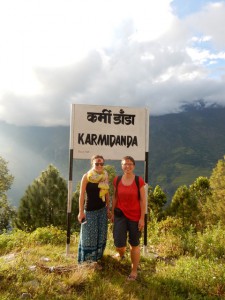
We didn´t go to our school in Karmidanda empty-handed. Close friends and family members gave us 400 € to buy missing school material. This action was carefully prepared by our friend, the teacher Jhabraj Neupane.
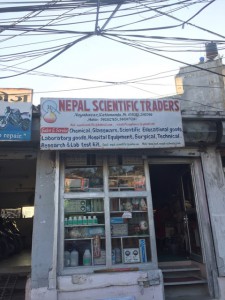 The purpose of the money and prepared a list of the most urgently needed things.In a specialty shop in Kathmandu, we bought visual and experimental materials for chemistry, physics and biology lessons. The result was surprising not only for us, but also for the shopkeeper. He gave us all the book at a special price with enthusiasm. Once the jeep was full loaded, we started our journey!
The purpose of the money and prepared a list of the most urgently needed things.In a specialty shop in Kathmandu, we bought visual and experimental materials for chemistry, physics and biology lessons. The result was surprising not only for us, but also for the shopkeeper. He gave us all the book at a special price with enthusiasm. Once the jeep was full loaded, we started our journey!
At our arrival, the teachers and students received us curiously. The packages were frenetically unpacked and a telescope quickly became a highlight!Somehow we thought it was like Christmas … the joy was huge. A heartfelt thanks to all the donors!
Until now we couldn´t imagine that all natural sciences were only taught theoretically using textbooks without images.
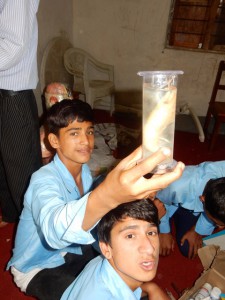 At present almost the entire lessons of the 10 classes take place in makeshift two-lined corrugated iron huts. We took part in some of the lessons to get our own picture.
At present almost the entire lessons of the 10 classes take place in makeshift two-lined corrugated iron huts. We took part in some of the lessons to get our own picture.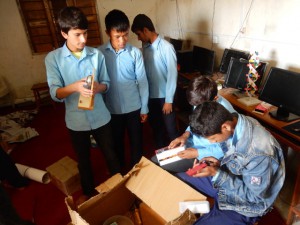
We couldn´t understand a word and the teacher took a self-evident break. We asked him how he could teach to such a big number of students and she replied smiling: “You should come back here during the rainy season. Then rain is so strong and drums so loudly on the tin roofs that the lessons must be turn out partially.”
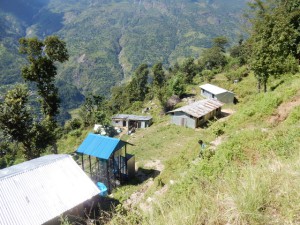
In his words, we immediately had a flashback of our first sleepless night in our accommodation in Karmidanda, when it rained so heavily and terribly. At least, that was our impression, but for our friend, however, it was just the last drizzle of the past rainy season. Reconstruction has not been an easy task! The originally planned site for the new two-storey building was firstly rejected, because extreme climatic conditions represent a great challenge for the construction.
Violent down pouring water masses, as well as the 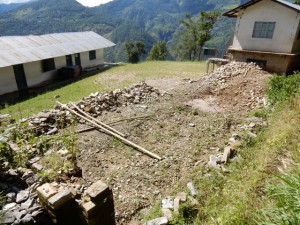 risk of a subsequent landslide, had to be taken under consideration. Similarly, regularly onset before the rainy season, extreme storms were observed. For example, in the past rainy season the path to the school was washed away. Stone blocks had to be re-piled up and the route partially had to be laid completely.
risk of a subsequent landslide, had to be taken under consideration. Similarly, regularly onset before the rainy season, extreme storms were observed. For example, in the past rainy season the path to the school was washed away. Stone blocks had to be re-piled up and the route partially had to be laid completely.
Together with an Italian friends and consultants, as well as the local architects, the Walk Alpin association has given preference to a protected location. A school building severely damaged as a result of the earthquake was already demolished this year and now made room for the new one.
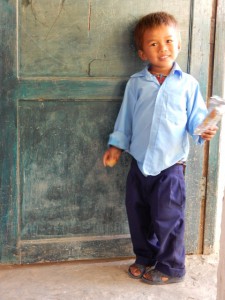 The rainy season is finally over and the construction can begin. Last difficulties were solved during our staying. Building material can now be ordered and, starting in the middle of November, a volunteer from Germany will stay in Karmidanda on behalf of WalkAlong eV and will supervise the construction by local builders.
The rainy season is finally over and the construction can begin. Last difficulties were solved during our staying. Building material can now be ordered and, starting in the middle of November, a volunteer from Germany will stay in Karmidanda on behalf of WalkAlong eV and will supervise the construction by local builders.
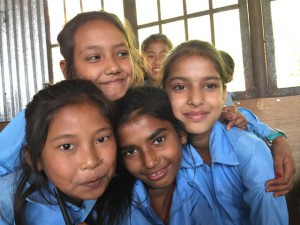
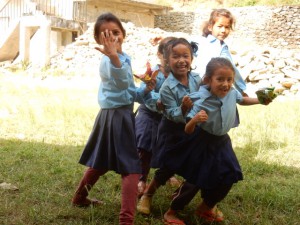
Many unforgettable moments, impressions, experiences, but above all the cordial hospitality made our trip through this beautiful nature something very special.
Two Colourful classrooms
The project:
We have come this far! Thanks to our partner Roberto, who is currently managing and planning in Nepal on behalf of Walk Along, we have worked together with our Nepalese architect to compile a detailed calculation as well as the blueprints and models of the two classrooms.
With the support and advocacy of our strategy by the School Management Committee (SMC), the local leaders and the local community, we are now ready to start the school restoration.
Construction work is expected to start after the rainy season in September 2016. The duration of the construction phase is set at 100-120 days – taking into account national and regional holidays. A flow chart and a calendar with entered strengths will contribute to the structuring.
The budget planning includes the following items:
Material + 2 skilled tradesmen + 3 workers + 1 technician + 1 supervisor
The payments of Walk Along will be made in five consecutive instalments according to the following model:
1. at the beginning (worker + material)
2. after the creation of the foundation (worker)
3. after the walls ‘raising (material)
4. after the completion of the body (material)
5. after the completion of the two classrooms (workers)
The money aspect will be run by our architect in Nepal. In addition, our friend and partner Gopal Neupane will continue to be on the spot.
 In our recent talks with various specialists and the SMC, another serious aspect has been highlighted. The land and soil management lack of specialist knowledge.
In our recent talks with various specialists and the SMC, another serious aspect has been highlighted. The land and soil management lack of specialist knowledge.
As a result, the protection of the soils and sites cannot currently be guaranteed. Only in June 2016 two provisional classrooms were destroyed by a landslide. We want to focus on this aspect in our future activities.
Acts of the government
 The progress of the reconstruction depends strongly on the regional political parties. The government wants to capture the emergency of each family in order to provide for the appropriate disbursements individually. In an area where a multitude of Nepalese do not even have their own identity card, this is nearly impossibile. Lists of donor-entitled families already published by the government do not agree with the expectations of the population, which leads to tensions on the ground.
The progress of the reconstruction depends strongly on the regional political parties. The government wants to capture the emergency of each family in order to provide for the appropriate disbursements individually. In an area where a multitude of Nepalese do not even have their own identity card, this is nearly impossibile. Lists of donor-entitled families already published by the government do not agree with the expectations of the population, which leads to tensions on the ground.
People´s mood
 After more than a year from the earthquake, the uncertainty of the Nepalese is growing. The construction of an earthquake-proof house (3-4 rooms) costs around 10,000 – 15,000 US $. This burden, as well as the absence of development and economic progress, are the main reason why young men are considering moving out of the villages.
After more than a year from the earthquake, the uncertainty of the Nepalese is growing. The construction of an earthquake-proof house (3-4 rooms) costs around 10,000 – 15,000 US $. This burden, as well as the absence of development and economic progress, are the main reason why young men are considering moving out of the villages.
In addition, the fear of further earthquakes makes moving to flatter lands more attractive.
Asterix in Nepal
We are pretty sure that most of you know the following scene from “Asterix conquered Rome“: Asterix and Obelix have the task to get passport A38 from an office. It sounds easy, but turns out to be very difficult. They are constantly sent from one person to another person, from one room to another room, from one floor to another floor! We feel exactly the same at the Department of Education (DoE) in Nepal.
You might wonder why…
October 2015:
We are making the first attempts to submit all the forms at the DoE and to prepare the building contract – the Memorandum of Understanding (MoU). The first difficulty is to find competent persons with helpful information. There are two experts, but both of them are already on vacation.
After two weeks of holiday rest the next step. Applications are submitted, the raw forms of the MoU are filled in and completed, and a list of missing documents is drawn up.
The only problem is the waiting for state-designed, earthquake-proof blueprints that have not yet been completed six months after the earthquake.
November / December 2015 Our friends from the youth social work in Nordhausen visit Karmidanda. Taking advantage of this opportunity, they are looking for the DoE to pick up the blueprints we asked for. Unfortunately without success. Suddenly, according to the DoE, we need further legitimations and additional written agreements. At this point we are a bit confused.
January – March 2016
Our Nepalese colleagues are making several attempts to get the MoU approved. Each time without success due to allegedly incorrect formulations or absence of competent employees at the Office.
February 2016
More and more documents are required.
March 2016
Nicole goes to Nepal. The DoE has again come up with something new: a Nepalese organization must now be added to the administration of the building funds.
But finally positive news: our documents were accepted. Now the approval of the Ministry of Education is needed.
April 2016
We are still waiting for the approval of the Ministry of Education.From our point of view, it is completely incomprehensible that a development project will put so many stones in the way. The Nepalese population is still waiting for the reconstruction and the progress of promised projects. Therefore, we will continue to work with full pressure on our vision and hope to reach the breakthrough as soon as possible!
Furniture for primary school
Aiutiamo il Nepal
We have joined the Italian relief organization AIUTIAMO IL NEPAL-I PEDALALENTA . All the founds have been combined in order to carry out the reconstruction process jointly. Roberto, one of the volunteers of the organization, met Valentina during her stay in Karmidanda. A week ago, a meeting took place between the two organizations, which clarified the details of further action.
